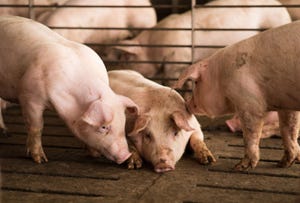Time is ticking to avert government shutdown
Legislative Watch: DACA roadblock to government staying open; U.S. open again to Mexican pork imports; pork inspection to be modernized; record corn and soybeans in ’17; Barbic picked for USDA post.

Congress is still trying to avoid a government shutdown at midnight tonight, but prospects in the Senate are dim. The House passed a continuing resolution that would fund the government through Feb. 16 and extends the children health insurance program.
The Senate Republican leadership wants to pass the House passed bill while Democrats want a Deferred Action for Childhood Arrivals agreement to be a part of any agreement. After last week’s meeting at the White House with various Senators and President Trump, DACA has become the major issue with many Democrats not supporting a CR until DACA is resolved.
It will take 60 votes in the Senate to pass the CR. At least four Republicans are opposed to the measure as are most Democrats. There will need to be at least 13 Democratic votes to pass the bill. Some Senators are suggesting a four- or five-day CR to give time to try and resolve the DACA issue.
U.S. open for Mexican pork
USDA’s Animal Plant and Health Inspection Service has finalized a rule that will allow pork to be imported into the United States from all Mexican states. APHIS determined that Mexico is free of classical swine fever and the risk is negligible.
The National Pork Producers Council supported the decision saying, “The U.S. pork industry is a strong supporter of free trade and of using epidemiological science and risk analyses to determine if trade can be safely conducted between countries. Mexico in 2017 was our No. 2 export market, so maintaining our good relationship with that country by ensuring fair and reciprocal trade is paramount for our producers.”
CSF was eradicated in the United States in the late-1970s.
USDA proposes rule to modernize pork inspection
USDA’s Food Safety and Inspection Service is proposing a rule that will modernize swine slaughter inspection through science-based approaches to food safety. The proposed rule, New Swine Slaughter Inspection System, would establish a voluntary inspection system for market hog slaughter establishments and would require additional pathogen sampling for all swine slaughter facilities.
The proposed rule will give pork plants greater responsibilities for slaughter inspection while maintaining 100% FSIS carcass-by-carcass inspection. This will allow FSIS staff to focus on food safety verification.
Currently, there are five pork plants participating in a FSIS pilot project. The proposed rule would make all market hog slaughter establishments eligible to participate in the new program.
There will be a 60 day comment period once the rule is published in the Federal Register.
2017 record corn yield and record soybean crop
In 2017, the United States had the highest corn yield on record and the largest soybean crop on record. This is according to the “Crop Production 2017 Summary” released by USDA’s National Agricultural Statistics Service.
NASS estimates the corn yield in 2017 at a record high of 176.6 bushels per acres which is 2.0 bushels above 2016. Area harvested was 82.7 million acres, down 5% from 2016. Total production was 14.6 billion bushels, down 4% from 2016.
The 2017 soybean crop hit a record 4.29 billion bushels, up 2% over 2016. The average soybean yield is estimated at 49.1 bushels per acre which is 2.9 bushels per acre below 2016’s record yield.
NASS is estimating the 2018 winter wheat acreage at 32.6 million acres, down less than 1% from 2017. This is the second lowest U.S. winter wheat acreage on record.
Barbic nominated to be USDA assistant secretary for Congressional relations
President Trump has nominated Ken Barbic to be USDA’s assistant secretary for Congressional relations. Since 2009, Barbic has been senior director for federal government affairs for Western Growers. Previously, he served as deputy assistant U.S. trade representative for congressional affairs.
About the Author(s)
You May Also Like



